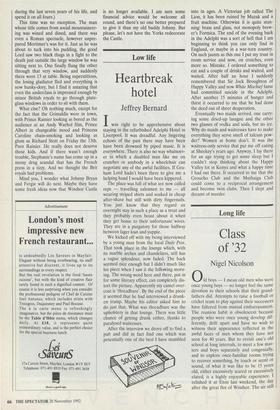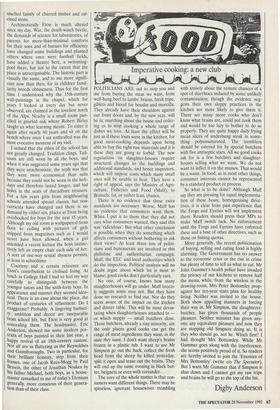Long life
Class of '32
Nigel Nicolson
Old boys — I mean old men who were once young boys — no longer feel the same devotion to their schools that their grand- fathers did. Attempts to raise a football or cricket team to play against their successors have faltered from mutual embarrassment. The reunion habit is obsolescent because people who were once young develop dif- ferently, drift apart and have no wish to witness their appearance reflected in the awful faces of men whom they have not seen for 40 years. But to revisit one's old school at long intervals, to meet a few mas- ters and boys separately and congenially, and to explore once-familiar rooms trying to recover something, by touch or scent or sound, of what it was like to be 15 years old, either excessively scared or excessively elated, is a highly enjoyable experience. I relished it at Eton last weekend, the day after the great fire of Windsor. The air still smelled faintly of charred timber and cal- cined stone.
Architecturally Eton is much altered since my day. War, the death-watch beetle, the demands of science for laboratories, of parents for more-than-minimal comforts for their sons and of bursars for efficiency have changed some buildings and planted others where once were football fields, have added a theatre here, a swimming- pool there, but not to the extent that the place is unrecognisable. The historic part is visually the same, and to me more signifi- cant now than then, for in children famil- iarity breeds obtuseness. Thus for the first time I understood why the 15th-century wall-paintings in the chapel, which for years I looked at every day but never observed, are claimed as the loveliest north of the Alps. Nearby is a small room pan- elled in gnarled oak where Robert Birley taught us what learning meant. To enter it again after nearly 60 years and sit on the bench where once I sat enthralled was the most evocative moment of my visit.
I sensed that the ethos of the school has not greatly changed. Tradition clings. Tail- coats are still worn by all the boys, and when it was suggested some years ago that they were anachronistic, the reply was that they were more economical than suits because they could not be worn in the holi- days and therefore lasted longer, and hid holes in the seats of threadbare trousers. For a few years girls from neighbouring schools attended special classes, but now curricula have changed and there is no demand by either sex, places at Eton being overbooked for boys for the next 15 years. Although my old room is wallpapered from floor to ceiling with pictures of girls snipped from magazines such as I would never have been allowed, when a girl attended a recent lecture the boys instinc- tively left an empty chair each side of her. A sort of one-way sexual shyness persists, at least in schooltime.
Courtesy and a certain reticence are Eton's contribution to civilised living. At lunch in College Hall I had to feel my way carefully to distinguish between the Younger tutors and the sixth-form boys. In appearance and manner they seemed iden- tical. There is an ease about the place, the product of centuries of refinement. Do I exaggerate? Probably. A lingering barbari- ty, ambition and deceit are inseparable from school life, but Eton is very good at concealing them. The headmaster, Eric Anderson, showed me some modern por- traits of boys painted in their last year, a happy revival of an 18th-century custom. Not all are as flattering as the Reynoldses and Gainsboroughs. Two in particular, for their brilliant honesty, step from their frames, one of Jacob Rees-Mogg by Paul Brason, the other of Jonathan Noakes by his father Michael, both boys, as a house- master remarked to me of today's Etonians generally, more conscious of their genera- tion than of their class.











































































 Previous page
Previous page